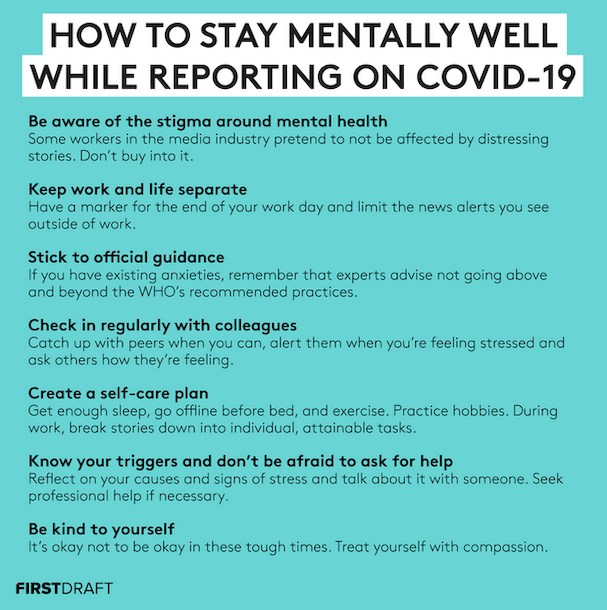How newsroom managers can support journalists covering the COVID-19 outbreak
Covering the worst health crises in the past century can take a toll on journalists’ mental health. Here’s what news managers can do to support them during this difficult time.
Reporters find themselves on the frontlines of the coronavirus outbreak. Not only are some putting their health at risk to keep readers informed, the relentless pace of the 24-hour news cycle, as well as having to focus intensely on the issue for many hours at a time, can take a mental and physical toll.
A standard strategy for coping with anxiety is to remove yourself from the news cycle and get some exercise – both challenging for journalists covering the news and or in lockdown.
However, it’s important to take your mental health seriously, and not be afraid to reach out for help when dealing with disturbing information all day is becoming too much.
Many news organisations have ordered staff to work from home whenever possible in order to reduce the chance of them contracting the virus. This, however, takes away the direct support from others in the newsroom, and makes it more difficult to gauge how people are dealing with the situation.
Additionally, editors are saying that the novelty of being at home is starting to wear off, and staff are beginning to feel the negative effects of remote work, such as dealing with difficulties around communication, being unable to escape negative news, and experiencing challenges managing their personal circumstances.
Checking in with staff on a regular basis
Against this backdrop, it's important news managers check in with staff on a regular basis, and make sure they comfortable enough to let them know if they need additional support to deal with the situation or require some time off to recuperate.
The Quint in India holds several Skype meetings a day so that people working from home are not feeling isolated or lonely. Currently, only a few people are coming into the office for shoots and edits, with those who normally use public transport to get there being provided with pick-ups and drop-offs. The Quint has also cut down on on the ground reporting, and makes sure no one is sent to crowded areas.
In addition to touching base several times per day, Slack and WhatsApp channels that have been set up to fact check misinformation are also being used to create and share memes, “which is great to keep everyone’s spirits up a bit,” says The Quint’s CEO and founder, Ritu Kapur.
At VG in Norway, one health editor is holding a daily workout session via FaceTime anyone can join, helping people take their mind off work.
Putting safety first
At The Straits Times in Singapore, editors check in with staff working from home via emails, WhatsApp messages and Hangouts, not just for work-related discussions but to stay connected in general.
Editor-in-Chief Warren Fernandez also stresses the importance of making sure staff know that their safety is a top priority.
“We have to make clear to them that while we want them to get the story, their safety matters more to us,” he says. “We want them to live to tell the story, over and again.”

FirstDraft has these tips on how to stay mentally well while reporting on COVID-19.
In general, newsrooms should be putting great emphasis on self-care at this time, and devise ways for staff to blow off steam, such as organising group sessions to share experiences or simply give them time off to relax, according to Javier Garza, a journalist and safety advisor for the World Editors Forum board.
“Peer support, psychological well-being, and trauma awareness are very important,” he says.
He also encourages journalists to identify activities that help them relax and clear their mind, such as physical exercise, meditation, reading, or watching films, and that they take time out of their day to focus just on themselves. The Dart Center for Journalism and Trauma, a project of the Columbia Journalism School, has published several resources on self-care for journalists covering disasters or other traumatic events.
“Also, be very aware of the effect of consuming too much social media, too much fake news, myths and disinformation,” Garza says.
Alleviating fears
News managers should also address other anxieties brought about by the virus.
Due to its economic impact, many journalists are already experiencing uncertainty about the health of the news organisations they work for, says Garza.
“I think newsroom leaders have to be very reassuring about the future. I know sometimes even editors and managers don't know, but it's important to stress the team effort of a difficult coverage such as this one. Editors have to be the bridge between the newsrooms and top executives, and will have to advocate for their reporters and editors when the crunch comes.”